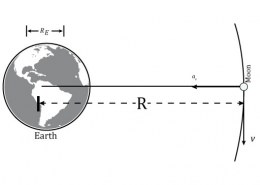Newton’s Law of Universal Gravitation states that every particle in the universe attracts every other particle with a force. This force is directly proportional to the product of their masses and inversely proportional to the square of the distance between them.
NCERT Class 11 Physics
Gravitation
CBSE EXAM 2024-25

In 1665, Sir Isaac Newton observed an apple falling from a tree, inspiring him to formulate the law of gravitation. He hypothesized that the same force pulling the apple towards the Earth also kept the Moon in its orbit. By comparing the acceleration due to gravity experienced by the Moon and objects near the Earth’s surface, Newton developed his theory of gravitation.
Newton assumed the Moon moved in a circular orbit with a radius of R (= 3.84 x 10⁸m) and an orbital period of T = 27.3 days = 27.3 x 86,400s.From this, he calculated the Moon’s speed and centripetal acceleration. The Moon’s centripetal acceleration was much smaller than the acceleration due to gravity on the Earth’s surface (g = 9.8 ms ⁻² ).
Newton proposed that the gravitational force weakens with increasing distance from the Earth’s center, following an inverse-square law. Using the Earth’s radius Rₑ, he demonstrated that:
a꜀ = (Rₑ/R)² x g.
With Rₑ/R = 1/60, the calculated value of a꜀ matched the observed value, confirming the inverse-square relationship. This test, known as Newton’s “Moon Test,” validated his hypothesis.
Newton also concluded that the gravitational force is proportional to the masses of the interacting objects. By applying the third law of motion, he showed that the forces are equal and opposite. These insights led to the formulation of Newton’s Universal Law of Gravitation, describing how all objects in the universe attract one another.